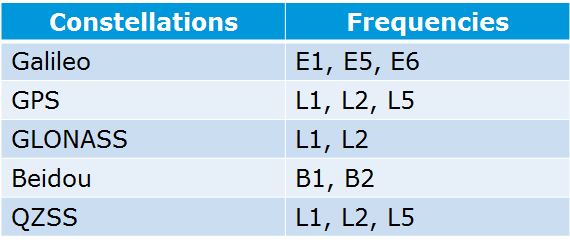Navigation Laboratory
The Radio Navigation Systems and Techniques Section manages the receivers laboratory where there are all the required tools and equipment to test GNSS receivers, this includes two vans used to perform on the field measurements. The receivers laboratory works closely with the UTC and Payload laboratories.
The receivers laboratory has the following capabilities:
- Signal simulators
- Signal recording and play back
- Antenna farm of mass-market and professional antennas
- Mass-market, test-user receivers and professional receivers
- Hybrid positioning test-bed
- Software simulation tools
- Software Defined Radio tools
- Test-bed to simulate signal anomalies
- Anti-Spoofing test-bed
- GNSS signal processing in the cloud
- EGNOS test user receiver
Signal Simulators

The laboratory has a wide range of GNSS signal simulators. It has from simple single frequency simulator to very advanced multi-frequency multi-constellation simulators. Integrated with the signal simulators there are inertial simulation capabilities that allow to generate all the signals coherently to exactly match the simulated vehicle trajectory and simulate typical inertial sensor performance.

The simulators in the lab are tailored to the section needs, they support advanced technologies that are the forefront of current R&D activities:
- 4 Element beamforming system: 4 independent RF outputs, each providing 12 channels Galileo, 12 channels GPS
- 2 x 4 element reflectometry system (PARIS): 2 x 4 independent RF outputs, each providing 1 channel GPS
The laboratory also looks into the market trends for location based services. The laboratory hosts an assisted GNSS simulator. This simulator interfaces with the GNSS simulators mentioned before and provide the following capabilities:
- LTE-LBS
- LPP 3GPP minimum performance
- A-GNSS over LTE
- OTDOA
- LBS OTDOA
- ECID

The test bed includes a small Faraday cage where it is possible to perform radiated tests with mobile phones.
Interference detector
The laboratory has an interference detector used to characterize interference. It builds an interference database that can be shared and allows the usage of others databases, building a shared interference database. It also provides jamming and spoofing alerts and allows to replay the detected interference.
| Constellations | Frequencies |
| Galileo | E1, E5a |
| GPS | L1, L5 |
Van

As part of the laboratory capabilities , the lab also owns two vans used to perform field tests. The vans are used with two purposes, one perform real-time measurements with GNSS professional and mass-market receivers driving in the different environments like, open sky, sub-urban and urban. At the same time that GNSS receivers are tested, the van is equipped with recording capabilities. The same signal that the receivers are receiving is recorded for after test analysis and playback in the lab. This allow our engineers to replay the same signal as many times as required and compare results using the same signal with many receivers.
Record and Replay

Being able to record the GNSS signals is very important for the activities performed in the laboratory. Performing recordings of the GNSS signals is very useful to compare performances of different receivers using exactly the same signal. Also due to space limitations in the van it is not possible to carry at the same time all the available receivers.

By being able to record and replay GNSS signal it is possible to assess differences in performance of receivers for instance after a firmware upgrade it is possible to assess how this upgrade impacts the performance of a particular receiver.
The laboratory has a wide range of record and replay capabilities each one suited for different purposes. The equipment in the lab is able to record the whole GNSS band.
Receivers
The laboratory has mass-market receivers and professional receivers. The mass-market receivers include chipsets from the main chipset manufacturers around the world.
Test User Receivers
The test-user receivers are a very important tool in the lab. These receivers allow the engineers to get deep in the user receiver technology. They allow operations that are impossible for normal receivers. The laboratory has Galileo Test user receivers (TUR-N) and EGNOS test user receivers.
The TUR-N covers a wide range of receiver configurations to demonstrate the future Galileo-only and GPS/Galileo combined services:
- Galileo single and dual-frequency Open Services (OS)
- Galileo single and dual-frequency safety-of-life services (SoL), including the full Galileo navigation warning algorithms
- Galileo Commercial Service (CS), including tracking and decoding of the encrypted E6BC signal
- GPS/SBAS/Galileo single and dual-frequency multi-constellation positioning
- Galileo single and dual-frequency differential positioning.
- Galileo triple-frequency RTK.
The EGNOS test user receiver supports the aeronautical, maritime and railway modes. Supports GPS L1, L5. Galileo E1, E5a. SBAS L1 and L5 and has a great degree of configurability for:
- FE Bandwidth, Gain, sampling frequency, quantization.
- Number of channels, discriminator type, loop bandwidth, correlator spacing, multipath detection and mitigation techniques
- Interference detection and mitigation techniques
- Output rate
- Error distortion module
Software simulation tools

The laboratory has three simulation tools available to the users
- Ray-tracing tool: Combines ray-tracing technologies with state of the art graphic-rendering 3D to provide the best in sensor simulation. It can also communicate real-time with the hardware GNSS signal simulators and create complex multi-path environments like 3D urban scenarios.
- Orbit determination tool.
- Interactive multipurpose tool to process and analyze GNSS data at observable level (PVT engine).
For more information please contact:
Michelangelo.Albertazzi @ esa.int
Paolo.Crosta @ esa.int

